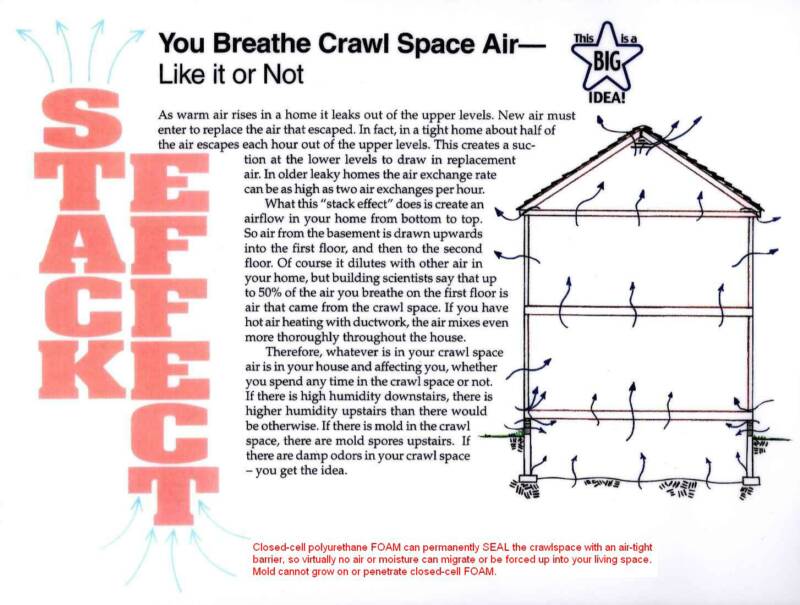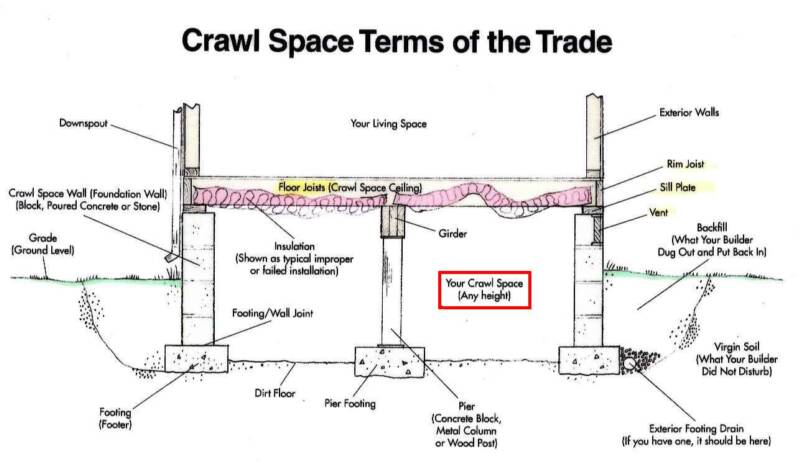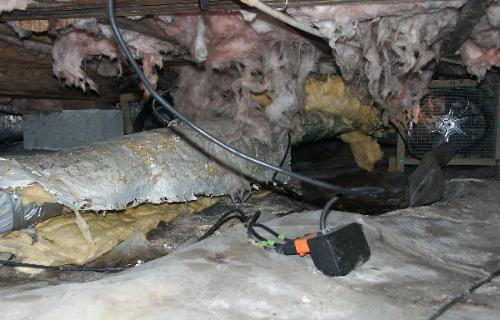

Whether you have a crawlspace or not,
BAD air is being sucked into your house...
by STACK EFFECT
Closed-cell polyurethane FOAM can permanently SEAL the crawlspace with an airtight barrier (walls & ceiling), so that virtually no air or moisture can migrate or infiltrate up into the living space (via stack effect ). One of the greatest benefits in foaming the crawl space (walls & ceiling) is that MOLD cannot travel into the living space through air infiltration. Also, mold cannot grow on (or penetrate) closed-cell foam (plastic).
Click here ALSO see HOT ROOF and eliminate STACK EFFECT.
SEVEN Reasons to insulate your crawl space ceiling (the subfloor of your 1st floor) with
closed-cell Sprayed Polyurethane Foam (SPF):
1. Stop the movement of ALL unhealthy air and moisture from the crawl space into your living environment above the crawl space.
2. Prevents air and moisture from reaching the wood--so that there is no air or moisture to support mold growth on the wood.
3. Stops bacteria, rodent, and insect penetration into the home (cellulose and fiberglass create nesting material for squirrels & rats).
4. Thermal insulation to keep the floor warm. (No voids, settling, or penetrations as with fiberglass and cellulose.)
5. May stop the creaking of floors because it adds 500 lbs per sq. in. to the structural integrity of the floor (hundreds of times stronger).
6. Sound proofing reduces the sound travel from Heating and Air Conditioning systems under the floor, between walls, etc.
7. It is the only insulation that works under these conditions! ...and it has an INDEFINITE lifespan!
Air from living space is sucked into the attic creating a partial vacuum that pulls air through the floor below
Crawl space is typically full
of moisture, mold, and mildew.
Unhealthy air from crawl space is sucked into the living environment
Your Living Space
(Sealing above and below your living space with SPF creates an "envelop" of breathable air)
Warm air escapes,
creating suction
Notice sagging/soggy fiberglass falling away from the floor over time.
Stack Effect Sometimes called
"chimney effect"
See crawl space diagram below.
Crawl Space beneath your living space
And believe it or not, putting foam in your roof (attic) prevents the nasty air from from being sucked up from your crawl space into the air you breathe. Installing SPF foam above and below your living environment is your BEST protection from unhealty air.
Putting SPF foam in the roof line STOPS air in the attic from escaping (AND over-heating), thus stopping Stack Effect
Solution:
Put SPF foam
in crawl space ceiling
Value Tech Insulation Serves Metro Atlanta
and the Southeast U.S.
770-981-9090
Links: (We partner with other specialists)
Click here
Click for enlarged crawlspace view
Vapor barrier & foam together
keep out mold, insects and dust: Result: ultra CLEAN !
^ Notice:
preexisting wires
are NOT sprayed
Click on photos below to see the miticulous care we exercise in spraying.
Click
here

Exterior walls
of your house
Inevitable mold, moisture & infestation -- destroys the integrity of the fiberglass insulation, causing it to fall down.
Helping the "Building Green" revolution of energy savings for the planet and the pocket.
See U.S. Government "Green Home" building programs.
Care taken to sweep dirt & dust,
so that foam sticks well to concrete.
Duct work is sealed tight
Store valuable goods
Oak Ridge National Laboratory research shows that “perfectly installed” fiberglass batts lose 11% of their labeled
R-Value, and that “commonly installed” fiberglass batts lose 28% of their labeled R-value. This study confirms tests conducted 20 years ago by fiberglass manufacturers, and reveals the surprisingly large disparity between the labeled R-value and the installed R-value of fiberglass batts. The point is that R-Value is not the best measure of insulation and that fiberglass batt is the worst kind of insulation for a crawl space.
(Adobe Acrobat PDF reader needed) <<< click here
Without FOAM, your house is like a chimney.... venting air out of your house and money out of your pocket.
“Stack Effect”—sometimes called “chimney effect”—is the normal problem most all homes have, causing the air in your home to be sucked out. It also is often the cause of high humidity (and thus mold), even in a house that does NOT have a crawlspace. The process begins in the attic (and upper levels of multi-story houses). In summer, attic air reaches 120-180 degrees and escapes through vents and other penetrations. In winter, warmer air rises and creates the same suction. Even in a relatively well-sealed home about half of the air escapes each hour out of the upper levels. The problem is endemic because the standard design of homes is to vent air out the top. This creates suction on the lower levels, pulling air from the lower part of your house into the attic and out of the house. Of course the air in the house below must be replaced, and in older homes the leakage can be as high as two air exchanges per hour. This is the primary contributor to your energy loses, and can affect your comfort levels (bodily and financial). Worse than the adverse effect on your comfort and energy, is the risk to your health. Building scientists say that in homes with a crawl-space, up to 50% of your air on the first level of your home comes from the crawlspace—often laden with high humidity, mold and bacteria. Your air conditioning and heating system spreads it throughout the house. Even the mold in your attic and HVAC ductwork (whether in the attic or crawlspace) comes from the crawlspace, as a result of spores traveling up and through your house.

